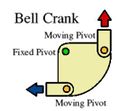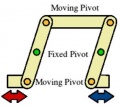Linkages: Difference between revisions
From DT Online
(Create Linkages Category) |
(Added links) |
||
| Line 3: | Line 3: | ||
Levers or links may be connected together using a wide range of fastenings which allow free movement - e.g. screws, pins, paper fasteners, pop rivets, clevis pins, nuts and bolts, etc. The linkage can be made to change the direction of a force or make two or more things move at the same time. | Levers or links may be connected together using a wide range of fastenings which allow free movement - e.g. screws, pins, paper fasteners, pop rivets, clevis pins, nuts and bolts, etc. The linkage can be made to change the direction of a force or make two or more things move at the same time. | ||
A linkage which makes things move in opposite directions is called a | A linkage which makes things move in opposite directions is called a '''[[Reverse Motion Linkage]]'''. A linkage which makes the output move in the same direction as the input is called a '''[[Push-Pull Linkage]]'''. | ||
Revision as of 13:45, 10 February 2015
A linkage is a 'mechanism made by connecting together levers.
Levers or links may be connected together using a wide range of fastenings which allow free movement - e.g. screws, pins, paper fasteners, pop rivets, clevis pins, nuts and bolts, etc. The linkage can be made to change the direction of a force or make two or more things move at the same time.
A linkage which makes things move in opposite directions is called a Reverse Motion Linkage. A linkage which makes the output move in the same direction as the input is called a Push-Pull Linkage.
Pages in category 'Linkages'
The following 5 pages are in this category, out of 5 total.
Media in category 'Linkages'
The following 6 files are in this category, out of 6 total.
- 4BarChain.jpg 322 × 189; 10 KB
- FourBarChain.png 322 × 189; 8 KB
- MechanismsBellCrank.jpg 265 × 246; 10 KB
- MechanismsParallelMotionLinkage.jpg 300 × 227; 10 KB
- MechanismsPushPullLinkage.jpg 296 × 265; 13 KB
- MechanismsReverseMotionLinkage.jpg 299 × 208; 10 KB





